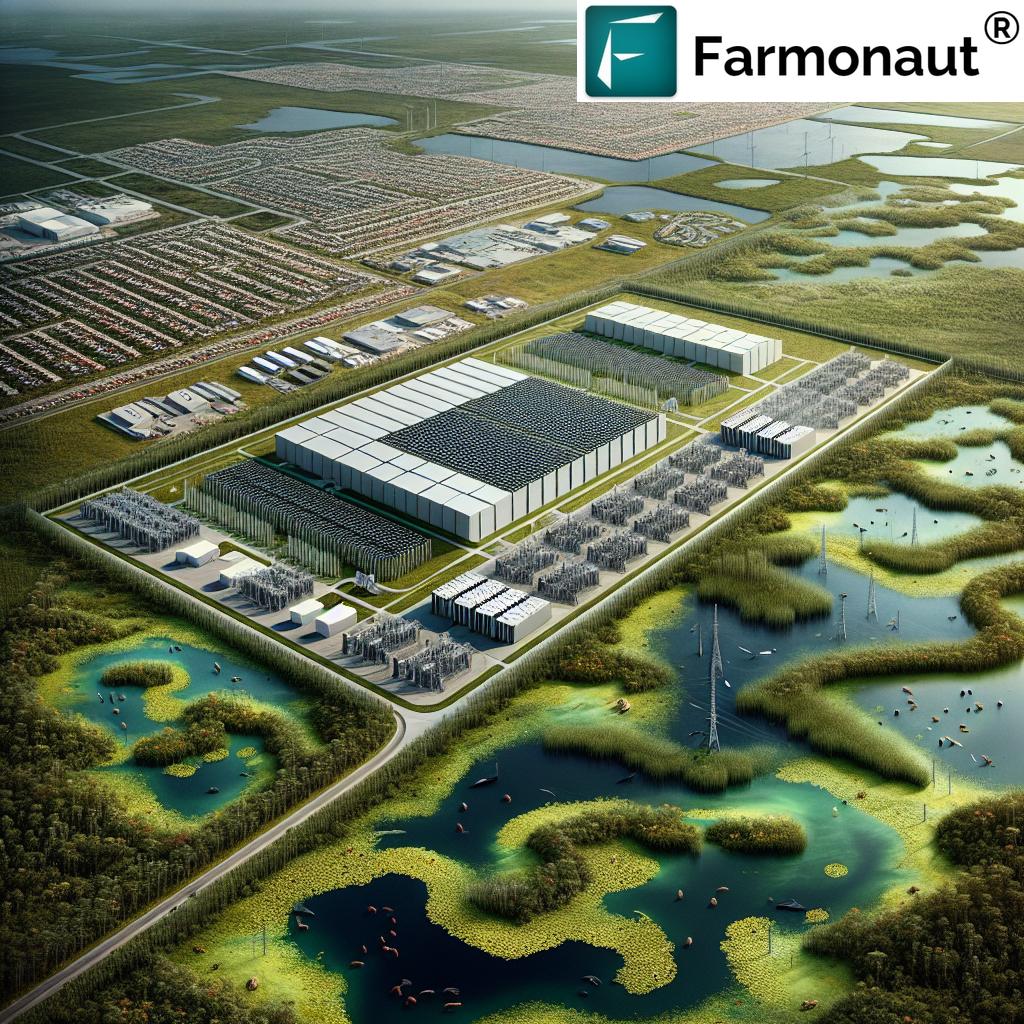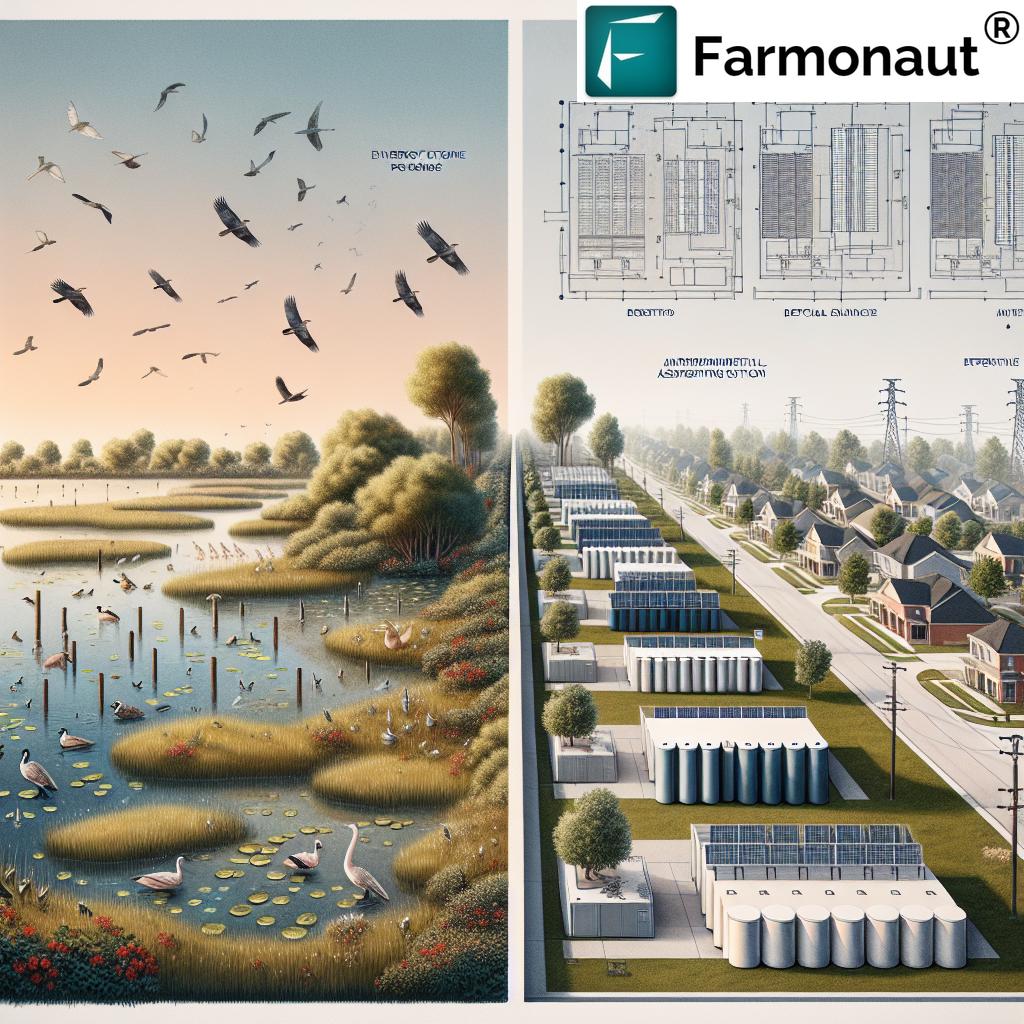Balancing Sustainable Energy and Ecosystem Protection: Pittsfield’s Battery Storage Dilemma
“The proposed battery storage facility in Pittsfield has sparked debate over its impact on nearby wetlands and water systems.”
In the heart of Pittsfield, Massachusetts, a contentious battle is brewing between the pursuit of sustainable energy solutions and the preservation of delicate ecosystems. The proposed battery storage facility on Williams Street has ignited a fierce debate, highlighting the complex challenges communities face when balancing renewable energy projects with environmental protection and residential concerns.
As we delve into this multifaceted issue, we’ll explore the intricate web of considerations surrounding the proposed battery energy storage system, from its potential benefits for sustainable power to the legitimate concerns raised by local residents. Our analysis will shed light on the delicate balance between advancing clean energy initiatives and safeguarding the natural environment that makes Pittsfield unique.
The Proposed Battery Storage Facility: An Overview
At the center of this controversy is a battery energy storage system planned for a 3-acre site at 734 Williams Street. Proposed by Boston-based solar company BlueWave, the facility aims to store energy from both traditional and renewable sources, serving as a crucial component in the region’s transition to more sustainable power solutions.
The site, owned by Alfred A. Barbalunga, is situated in a commercially zoned lot behind Williams Plaza. However, its proximity to residential communities on Stonehedge Road to the west and Alfred Drive to the south has raised significant concerns among local inhabitants.

The Promise of Sustainable Energy Storage
Battery energy storage systems play a vital role in the transition to renewable energy. These facilities can harness power from sustainable sources such as solar arrays and wind turbines, storing it for use when needed. This capability addresses one of the primary challenges of renewable energy: its intermittent nature.
By providing a reliable buffer between energy generation and consumption, battery storage facilities like the one proposed in Pittsfield can help:
- Stabilize the power grid
- Reduce reliance on fossil fuels
- Enable greater integration of renewable energy sources
- Improve energy efficiency and reduce waste
These benefits align with broader goals of reducing carbon emissions and combating climate change, making such projects attractive from an environmental perspective.
Community Concerns and Environmental Impacts
Despite the potential benefits, the proposed battery storage facility has met with significant opposition from local residents. Their concerns, voiced during a recent Conservation Commission meeting, touch on several critical issues:
Wetland Conservation and Flooding Risks
One of the primary concerns is the facility’s proximity to wetlands. Residents worry that alterations to these sensitive areas could exacerbate existing flooding problems. Patricia Turner, a Brookside Drive resident, aptly noted, “When wetlands are dug, dredged or filled, the water that made them wet has to go somewhere.”
This concern underscores the delicate balance of local ecosystems and the potential for unintended consequences when developing near wetlands. The project’s impact on water systems and overall ecosystem health remains a significant point of contention.
Wildlife Habitat Protection
The proposed site is home to a diverse array of wildlife, including bears, deer, raccoons, and various bird species. Residents like Kristin Smith have questioned the project’s impact on these animal populations, highlighting the need for comprehensive environmental impact assessments.
Noise Pollution
Battery storage facilities can generate significant noise, a concern for nearby residents. Despite plans for noise reduction walls, community members fear the constant hum of the facility will disrupt their quality of life.
Safety Concerns
In light of recent incidents at other battery storage facilities, such as a fire at a plant in Northern California, residents have expressed serious safety concerns. The potential for fires, explosions, or chemical leaks poses risks to both human health and the surrounding environment.

Regulatory Landscape and Project Approval Process
The proposed battery storage facility in Pittsfield must navigate a complex regulatory landscape before gaining approval. Key steps in this process include:
- Review by the Conservation Commission
- Site plan review by the Community Development Board
- Special permit approval from the Zoning Board
These multiple layers of scrutiny aim to ensure that the project meets all necessary environmental, safety, and zoning requirements. However, they also highlight the challenges faced by renewable energy projects in balancing regulatory compliance with community concerns and project viability.
Adapting Plans: Developer Response to Community Feedback
“Developers adjusted plans for the energy storage system, moving infrastructure further from homes to address community concerns.”
In response to community feedback, BlueWave has already made significant adjustments to their initial plans. Michael Carey, senior director of storage development at BlueWave, and Jesse O’Donnell, a project manager at engineering firm Weston & Sampson, presented these modifications at the recent Conservation Commission meeting.
Key changes include:
- Relocating infrastructure further from residential areas
- Adjusting the site layout to minimize impact on wetlands
- Incorporating noise reduction measures, including 12-foot walls on the west and south sides of the facility
These adaptations demonstrate the developers’ willingness to engage with community concerns and highlight the ongoing process of negotiation and compromise inherent in such projects.
Balancing Act: Energy Needs vs. Environmental Protection
The Pittsfield battery storage facility controversy epitomizes the broader challenges faced by communities worldwide as they transition to more sustainable energy systems. It raises fundamental questions about how we can balance our growing energy needs with the imperative to protect our natural environment and maintain quality of life for residents.
To better understand the nuanced impacts of this project, let’s examine a comparative analysis of its potential effects:
| Aspect | Potential Benefits | Potential Risks | Proposed Mitigation Measures |
|---|---|---|---|
| Energy Sustainability | Improved grid stability; increased renewable energy integration | Energy loss during storage; potential for technological obsolescence | Regular upgrades; integration with smart grid technologies |
| Wetland Conservation | Minimal if proper safeguards are implemented | Disruption of water flow; habitat alteration | Increased buffer zones; advanced water management systems |
| Wildlife Habitat | Potential for creating new habitats in buffer areas | Displacement of local species; disruption of migration patterns | Wildlife corridors; habitat restoration projects |
| Noise Pollution | None directly related to project | Constant low-frequency noise affecting residents and wildlife | Advanced noise reduction technologies; sound-absorbing barriers |
| Flood Risk | Potential for improved local drainage if designed correctly | Increased runoff; alteration of natural water flow | Permeable surfaces; rainwater harvesting systems |
| Community Safety | Enhanced energy security during outages | Fire hazards; potential for chemical leaks | State-of-the-art fire suppression systems; rigorous safety protocols |
This analysis underscores the complexity of the issues at hand and the need for comprehensive, multifaceted solutions that address both the potential benefits and risks of the proposed facility.
The Role of Technology in Mitigating Environmental Impacts
As we grapple with these challenges, it’s crucial to consider how advanced technologies can help mitigate the environmental impacts of energy storage facilities. While not directly related to the Pittsfield project, companies like Farmonaut are at the forefront of developing innovative solutions for environmental monitoring and sustainable resource management.
Farmonaut’s satellite-based monitoring technologies and AI-driven advisory systems offer potential applications for projects like the Pittsfield battery storage facility. These could include:
- Real-time monitoring of wetland health and water levels
- Tracking of wildlife movements and habitat use
- Assessment of vegetation changes in the surrounding area
- Monitoring of potential pollutants or chemical leaks
While Farmonaut’s primary focus is on agricultural applications, the principles behind their technologies could be adapted to enhance environmental protection measures for energy infrastructure projects.
For more information on Farmonaut’s innovative technologies, visit their web application or explore their API for developers.
Community Engagement and Transparency
The contentious nature of the Pittsfield battery storage project underscores the critical importance of community engagement and transparency in renewable energy developments. As we move forward, it’s essential that project developers, local authorities, and community members work together to find solutions that address all stakeholders’ concerns.
Key steps in this process should include:
- Regular community meetings and forums for open dialogue
- Transparent sharing of environmental impact assessments and safety protocols
- Exploration of community benefit agreements to ensure local residents see tangible advantages from the project
- Ongoing monitoring and reporting on the facility’s performance and environmental impacts
By fostering a spirit of collaboration and mutual understanding, it may be possible to find a path forward that balances the need for sustainable energy solutions with the imperative of protecting Pittsfield’s unique natural environment and residential quality of life.
The Broader Context: Renewable Energy and Community Development
The Pittsfield battery storage facility controversy is not an isolated incident but part of a broader trend as communities worldwide grapple with the challenges of transitioning to renewable energy systems. Similar debates are playing out across the globe, from wind farm developments to solar array installations.
These controversies highlight the need for comprehensive, forward-thinking energy policies that:
- Prioritize both environmental protection and sustainable energy development
- Provide clear guidelines for siting and operating energy storage facilities
- Encourage innovative technologies that minimize environmental impacts
- Ensure meaningful community involvement in energy infrastructure decisions
As we navigate these complex issues, it’s crucial to remember that the goal of sustainable energy is not just about reducing carbon emissions, but also about creating resilient, healthy communities that can thrive in harmony with their natural surroundings.
Looking Ahead: The Future of Energy Storage in Pittsfield
As the debate over the Williams Street battery storage facility continues, it’s clear that the outcome will have significant implications for Pittsfield’s energy future. Regardless of the final decision, this controversy has already sparked important conversations about how communities can balance their energy needs with environmental and quality of life concerns.
Moving forward, we can expect to see:
- Continued refinement of the project proposal to address community concerns
- Exploration of alternative sites or technologies that might offer a better balance of benefits and impacts
- Increased focus on comprehensive energy planning at the municipal and regional levels
- Growing interest in decentralized energy solutions that might reduce the need for large-scale storage facilities
Ultimately, the path to a sustainable energy future in Pittsfield and beyond will require ongoing dialogue, innovation, and a willingness to find creative solutions that work for all stakeholders.
FAQ: Pittsfield’s Battery Storage Facility Controversy
Q: What is the proposed battery storage facility in Pittsfield?
A: It’s an energy storage system planned for a 3-acre site at 734 Williams Street, designed to store power from both traditional and renewable sources.
Q: Who is proposing this project?
A: The project is proposed by BlueWave, a Boston-based solar company.
Q: What are the main concerns raised by residents?
A: Key concerns include impacts on wetlands, increased flood risk, noise pollution, wildlife habitat disruption, and safety issues related to battery technology.
Q: How have the developers responded to community feedback?
A: They’ve adjusted plans to move infrastructure further from homes and incorporated noise reduction measures, among other changes.
Q: What are the potential benefits of this facility?
A: Benefits include improved grid stability, increased integration of renewable energy, and enhanced energy security during outages.
Q: What regulatory approvals does the project need?
A: The project requires approval from the Conservation Commission, Community Development Board, and Zoning Board.
Q: How might this project impact local ecosystems?
A: Potential impacts include alterations to wetland hydrology, wildlife habitat disruption, and changes to local drainage patterns.
Q: What safety measures are being considered?
A: While specific details are still under discussion, industry-standard safety measures typically include fire suppression systems, containment mechanisms, and rigorous monitoring protocols.
Q: How can residents stay informed about the project’s progress?
A: Residents can attend public meetings, follow updates from the city’s planning department, and engage with community forums discussing the project.
Q: What lessons can be learned from this controversy?
A: This situation highlights the importance of early and transparent community engagement, comprehensive environmental impact assessments, and the need for balanced approaches to sustainable energy development.
Conclusion: A Watershed Moment for Pittsfield’s Energy Future
The controversy surrounding the proposed battery storage facility in Pittsfield represents a critical juncture in the community’s journey towards a sustainable energy future. It encapsulates the complex challenges faced by communities worldwide as they strive to balance the imperative of clean energy with the equally crucial need to protect local ecosystems and maintain quality of life for residents.
As we’ve explored, there are no easy answers to these challenges. The path forward will require ongoing dialogue, innovative thinking, and a willingness to compromise. It will demand that we look beyond short-term considerations to envision a future where energy infrastructure and natural environments can coexist harmoniously.
While the outcome of this specific project remains uncertain, what is clear is that the conversations it has sparked will shape Pittsfield’s approach to energy and environmental issues for years to come. By engaging in these difficult discussions and grappling with the complex trade-offs involved, Pittsfield has the opportunity to emerge as a leader in sustainable community development.
As we continue to monitor this evolving situation, let us remember that the goal of sustainable energy is not just about reducing carbon emissions or improving grid stability. It’s about creating resilient, healthy communities that can thrive in harmony with their natural surroundings. By keeping this broader vision in mind, we can work towards solutions that truly serve the best interests of all stakeholders – human and ecological alike.
The journey towards a sustainable energy future is not an easy one, but it is a necessary one. And with thoughtful planning, robust community engagement, and a commitment to innovation, it’s a journey that Pittsfield – and communities around the world – can successfully navigate.
Earn With Farmonaut: Affiliate Program
Earn 20% recurring commission with Farmonaut’s affiliate program by sharing your promo code and helping farmers save 10%. Onboard 10 Elite farmers monthly to earn a minimum of $148,000 annually—start now and grow your income!





